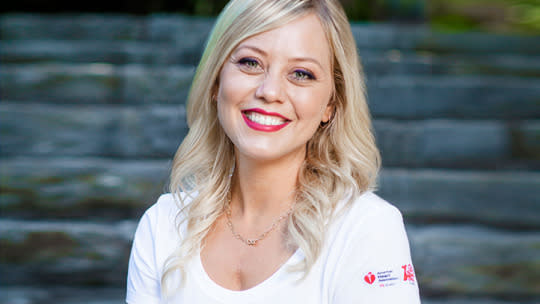Two Heart Attacks in My Twenties: A Survivor’s Story

(Courtesy Angela Baird Parker)
I sit calmly on a 747, my seat belt buckled low across my waist, and watch a flight attendant giving routine announcements. She’s probably wondering if anyone’s listening. “In case of emergency, an oxygen mask will drop from the ceiling. Place the mask over your mouth and nose. Breathe normally.” She demonstrates. “If you’re traveling with an infant or small child, place your mask on first before assisting others.”
I watch my fellow passengers send last-minute texts before switching to dreaded airplane mode and wonder if anyone heard the flight attendant. I also wonder if anyone else on my plane has learned the hard-knock lesson I have: If you want to care for others, you must first care for yourself.
Few things strike the core of being a woman like helping other passengers along life’s journey. Life, as it should be, is full of ups and downs. It’s quite like an airplane flight: Changing elevation is sometimes smooth, sometimes rough, and sometimes downright turbulent. You never know what to expect. Yet the caring nature of a woman remains mostly consistent among our gender, just like the routine pre-flight life instruction.
I was 22 when this lesson hit hard. I didn’t think much about my own health at the time. People were dying from lack of nutrition, and babies were sick from dirty water. Yet I had “oxygen-mask-resources” available to extend life and bring joy. Assisting others was all I wanted to do.
I joined a small team of nurses, social workers, and Christian missionaries through the deep African bush to bring medical supplies, clean water, and stories of our God. It was there that my mud hut home became the embodiment of another quality most common to women: heart disease.
My Unexpected Heart Attack Symptoms
Inside that mud hut, in the dark of night, I woke up on my smelly straw mat, and:
I couldn’t breathe.
My neck and chest were tight.
I was lightheaded.
I began vomiting.
My gut knew something was wrong.
Perhaps you already recognize these common symptoms for heart attacks in women. But for a 22-year-old healthy-eating, marathon-training, young person? No way.
In a medical evaluation one month later, my symptoms were dismissed and I was given a psychological evaluation. I’m not sure which was scarier: a heart attack in Africa or a doctor’s diagnosing me as “too emotional.” But both were scary enough for me to dismiss it and pretend nothing happened … until it happened again.
A Second Heart Attack
This time, at age 24, dehydrated and puking, my organs began failing, my lungs collapsed, and I became unconscious. My heart condition was so severe I needed emergency open-heart surgery. And let me tell you, this was even scarier than the experience and symptoms I was previously too afraid to acknowledge. I learned that my condition dated back to a misdiagnosed childhood illness involving inflamed arteries. At age five I had contracted Kawasaki disease. Now, 20 years later, only one-third of my heart worked, and two arteries needed bypassing.
Doctors said I wouldn’t make it.
RELATED: Why Heart Attacks Can Be Worse for Women
When I did, they said I would never again breathe without a respiratory machine. But I’m alive, breathing freely, and using my gift of life to sing God’s mercies. Today, I beg you to learn the preventable risk factors for heart disease that most women have.
I could be angry at the lack of women’s research, or at the doctors who misdiagnosed me with the flu, a heat stroke, exercise-induced asthma, or being too emotional. I’d rather retake the baton and make a difference, and this time take care of myself as I do.
Today, proudly wearing a scar on my chest, I’m healthy, full of joy, and a fitness instructor. I did more than recover: I found new life. I learned to put on my “oxygen mask” and take care of myself first, then to help others.
What You Should Know About Heart Disease
Women of all ages and races are flying through the risky, turbulent air of heart disease, but only half of us know it.
Heart disease, though largely undetected and understudied in women, kills one woman approximately every 80 seconds. More than all forms of cancer combined, heart disease is the leading cause of death among American women (as well as men), according to the Centers for Disease Control and Prevention. Its nasty head doesn’t always manifest itself like we think it would: a 70-year-old man clutching his chest and collapsing on TV.
Heart disease in women is sneaky. It’s scary. But knowledge is power, and what you don’t know can hurt you. So learn about heart disease in women. Educate yourself by scheduling a well-woman visit like the American Heart Association (AHA) recommends: an annual prevention check-up with your doctor to review your overall health and help prevent chronic diseases like heart disease and stroke.
Whether you’re on the road to recovery, or better yet, the road to prevention, listen to the stewardess next time. Life is full of smooth-sailing and turbulent times, but it’s worth it. Ask yourself: What does it mean to wear my oxygen mask?
Don’t wait another moment before you put yours on.
This article originally appeared on EverydayHealth.com: Two Heart Attacks in My Twenties: A Survivor’s Story
By Angela Baird Parker, Everyday Health
More from Everyday Health:
A Coach Gets Real: I Was a Pain Pill Addict
How to Survive Suicidal Thoughts
5 Healthy Comfort Foods to Reach For When You’re Happy or Stressed
